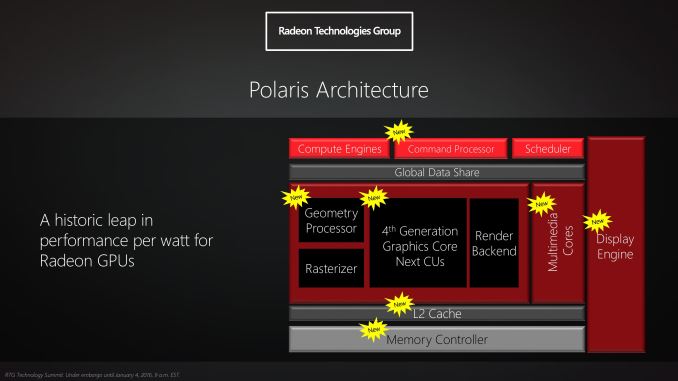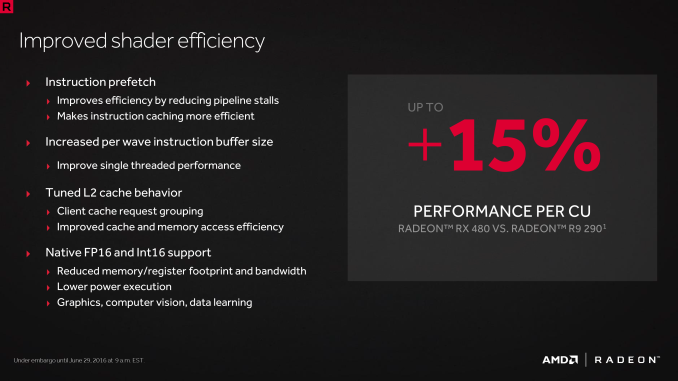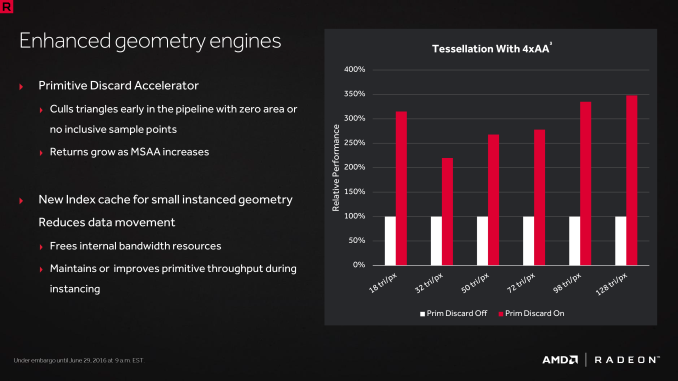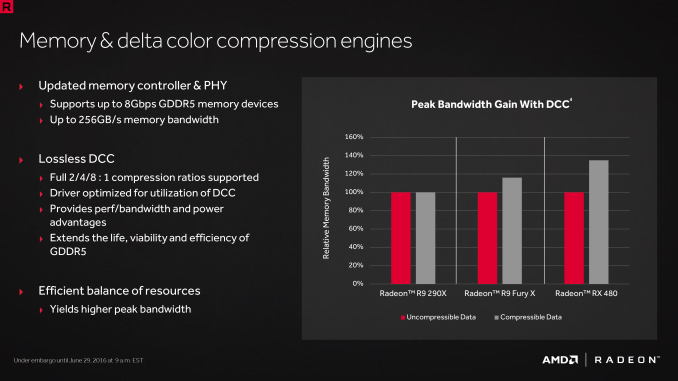The AMD Radeon RX 480 Preview: Polaris Makes Its Mainstream Mark
by Ryan Smith on June 29, 2016 9:00 AM ESTThe Polaris Architecture: In Brief
For today’s preview I’m going to quickly hit the highlights of the Polaris architecture.
In their announcement of the architecture this year, AMD laid out a basic overview of what components of the GPU would see major updates with Polaris. Polaris is not a complete overhaul of past AMD designs, but AMD has combined targeted performance upgrades with a chip-wide energy efficiency upgrade. As a result Polaris is a mix of old and new, and a lot more efficient in the process.
At its heart, Polaris is based on AMD’s 4th generation Graphics Core Next architecture (GCN 4). GCN 4 is not significantly different than GCN 1.2 (Tonga/Fiji), and in fact GCN 4’s ISA is identical to that of GCN 1.2’s. So everything we see here today comes not from broad, architectural changes, but from low-level microarchitectural changes that improve how instructions execute under the hood.
Overall AMD is claiming that GCN 4 (via RX 480) offers a 15% improvement in shader efficiency over GCN 1.1 (R9 290). This comes from two changes; instruction prefetching and a larger instruction buffer. In the case of the former, GCN 4 can, with the driver’s assistance, attempt to pre-fetch future instructions, something GCN 1.x could not do. When done correctly, this reduces/eliminates the need for a wave to stall to wait on an instruction fetch, keeping the CU fed and active more often. Meanwhile the per-wave instruction buffer (which is separate from the register file) has been increased from 12 DWORDs to 16 DWORDs, allowing more instructions to be buffered and, according to AMD, improving single-threaded performance.
Outside of the shader cores themselves, AMD has also made enhancements to the graphics front-end for Polaris. AMD’s latest architecture integrates what AMD calls a Primative Discard Accelerator. True to its name, the job of the discard accelerator is to remove (cull) triangles that are too small to be used, and to do so early enough in the rendering pipeline that the rest of the GPU is spared from having to deal with these unnecessary triangles. Degenerate triangles are culled before they even hit the vertex shader, while small triangles culled a bit later, after the vertex shader but before they hit the rasterizer. There’s no visual quality impact to this (only triangles that can’t be seen/rendered are culled), and as claimed by AMD, the benefits of the discard accelerator increase with MSAA levels, as MSAA otherwise exacerbates the small triangle problem.
Along these lines, Polaris also implements a new index cache, again meant to improve geometry performance. The index cache is designed specifically to accelerate geometry instancing performance, allowing small instanced geometry to stay close by in the cache, avoiding the power and bandwidth costs of shuffling this data around to other caches and VRAM.
Finally, at the back-end of the GPU, the ROP/L2/Memory controller partitions have also received their own updates. Chief among these is that Polaris implements the next generation of AMD’s delta color compression technology, which uses pattern matching to reduce the size and resulting memory bandwidth needs of frame buffers and render targets. As a result of this compression, color compression results in a de facto increase in available memory bandwidth and decrease in power consumption, at least so long as buffer is compressible. With Polaris, AMD supports a larger pattern library to better compress more buffers more often, improving on GCN 1.2 color compression by around 17%.
Otherwise we’ve already covered the increased L2 cache size, which is now at 2MB. Paired with this is AMD’s latest generation memory controller, which can now officially go to 8Gbps, and even a bit more than that when oveclocking.














449 Comments
View All Comments
Yojimbo - Thursday, June 30, 2016 - link
I don't think it has to do with objectivity, it has to do with relevance. The relevance of a review probably goes down quickly after release date. AT dropped the ball on 1080 and 1070. They don't want to drop the ball on the RX 480 as well.I understand your concern but I think unless there is a consistent bias towards AMD it's misplaced. This is just a single matter of practicality. I definitely can see being (and am myself) annoyed by the 1080 and 1070 reviews taking so long.
HollyDOL - Friday, July 1, 2016 - link
Um, not bias towards AMD, but rather they skip on biggest gpu performance jump in years and rather focus on card with medium performance (although, admittedly likely with biggest FPS/$ leap in years). I would be equally disturbed if the GTX-1080 perf bar card was released by AMD and they just skip it. Skipping Skylake cpu line would have prolly smaller impact than this technology wise.Yojimbo - Friday, July 1, 2016 - link
It's taking them entirely too long to get it out the door, but they aren't just skipping it. It's coming, so Ryan says.HOOfan 1 - Wednesday, June 29, 2016 - link
So, my burning question is.....did sacrificing your blood make the card any faster?Mr Perfect - Wednesday, June 29, 2016 - link
Will the 1070 be reviewed in the 1080 article too? Or is that coming later?bill44 - Thursday, June 30, 2016 - link
I hope I'm wrong about this, but there wont be a full FULL review until it includes the audio architecture (inc. sampling rates supported).It will be totaly game orientated, with barely a mention of madvr performance and decoding/encoding capabilities. Just like all the other reviews.
As I said, I hope I'm wrong about this, and it will be a FULL review.
Sandcat - Tuesday, July 19, 2016 - link
20 days later and still waiting for the RX 480.Stop lying, you aren't doing the 1080/1070 at all.
cocochanel - Thursday, June 30, 2016 - link
There are plenty of decent reviews on the GTX 1080 already.idris - Wednesday, June 29, 2016 - link
I'm wondering how 1070FE benches were added to this "preview"?! Disappointed with AT..Ryan Smith - Wednesday, June 29, 2016 - link
Just so it's noted, 1070FE benchmarks have been in Bench since late May.